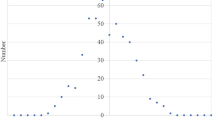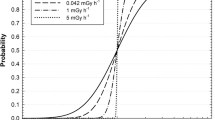Abstract
The risk of radiation-induced cancer is assessed through the follow-up of large cohorts, such as atomic bomb survivors or underground miners who have been occupationally exposed to radon and its decay products. The models relate to the dose, age and time dependence of the excess tumour rates, and they contain parameters that are estimated in terms of maximum likelihood computations. The computations are performed with the software package EPICURE, which contains the two main options of person-by person regression or of Poisson regression with grouped data. The Poisson regression is most frequently employed, but there are certain models that require an excessive number of cells when grouped data are used. One example involves computations that account explicitly for the temporal distribution of continuous exposures, as they occur with underground miners. In past work such models had to be approximated, but it is shown here that they can be treated explicitly in a suitably reformulated person-by person computation of the likelihood. The algorithm uses the familiar partitioning of the log-likelihood into two terms,L 1 andL 0. The first term,L 1, represents the contribution of the ‘events’ (tumours). It needs to be evaluated in the usual way, but constitutes no computational problem. The second term,L 0, represents the event-free periods of observation. It is, in its usual form, unmanageable for large cohorts. However, it can be reduced to a simple form, in which the number of computational steps is independent of cohort size. The method requires less computing time and computer memory, but more importantly it leads to more stable numerical results by obviating the need for grouping the data. The algorithm may be most relevant to radiation risk modelling, but it can facilitate the modelling of failure-time data in general.
Similar content being viewed by others
References
Andersen, Borgan, Gill, Keiding (1991) Statistical models based on counting processes. (Springer Series in Statistics) Springer, Berlin Heidelberg New York, p 177
Breslow NE (1979) Statistical methods for censored survival data. Environ Health Perspect 32:181–192
Breslow NE, Storer BE (1985) General relative risk functions for case-control studies. Am J Epidemiol 122:149–162
Breslow NE, Lubin JH, Marek P, Langholz B (1983): Multiplicative models and cohort analysis. J Am Stat Assoc 78:1–12
Cox DR (1972) Regression methods and life tables (with discussion). JR Stat Soc (B) 34:187–220
Gilbert ES (1989) Issues in analysing the effects of occupational exposure to low levels of radiation. Stat Med 8:173–187
Hornung RW, Meinhardt TJ (1987) Quantitative risk assessment of lung cancer in US uranium miners. Health Phys 52:41–43
ICRP (1991) The 1990–1991 Recommendations of the International Commission on Radiological Protection, Publication 60. Ann ICRP 21 (1–3). Pergamon Press, Oxford
ICRP (1994) Protection against radon-222 at home and at work. Ann ICRP. Pergamon Press, Oxford
Jacobi W, Henrichs K, Barclay D (1992) Verursachungs-Wahrscheinlichkeit von Lungenkrebs durch die berufliche Strahlenexposition von Uran-Bergleuten der Wismut AG. Gutachterliche Stellungnahme im Auftrag der Berufsgenossenschaften. Institut für Strahlenschutz des Forschungszentrum für Umwelt and Gesundheit, Neuherberg
Kalbfleisch JD, Prentice RL (1980) The statistical analysis of failure time data. Wiley, New York
Kellerer AM, Barclay D (1992): Age dependencies in the modelling of radiation carcinogenesis. Radiat Prot Dosimetry 41:273–281
Little MP, Charles MW (1991) Time variations in radiation-induced relative risk and implications for population cancer risks. J Radiol Prot 11:91–110
Little MP, Hawkins MM, Shore RE, Charles MW, Hildreth NG (1991) Time variations in the risk of cancer following irradiation in childhood. Radiat Res 126:304–316
Little MP, Hawkins MM, Shore RE, Charles MW, Hildreth NG (1992) Fitting the armitage-doll model to radiation-exposed cohorts and implications for population cancer risks. Radiat Res 132:207–221
Lubin JH, Gaffey W (1988) Relative risk models for assessing the joint effects of multiple factors. Am J Ind Med 13:149–167
National Research Council, Committee on the Biological Effects of Ionization Radiations (BEIR IV) (1988) Health risks of radon and other internally deposited alpha emitters. National Academy Press, Washington, DC
Pierce DA, Vaeth M, Preston DL (1991) Analysis of time and age patterns in cancer risk for A-bomb survivors. Radiat Res 126:171–186
Preston DL, Pierce DA (1988) The effects of changes in dosimetry on cancer mortality risk estimates in atomic bomb survivors. Radiat Res 114:437–466
Preston DL, Lubin JH, Pierce DA (1991) EPICURE. Generalized regression models for epidemiological data (software from Hirosoft International, Seattle)
Sevc J, Tomasek L, Kunz E, Placek V, Chmelevsky D, Barclay D, Kellerer AM (1993) A survey of the Czechoslovak follow-up of lung cancer mortality in uranium miners. Health Phys 64: 355–369
Shimizu Y, Kato H, Scholl WJ (1988) Life span study report 11, part 2: Cancer mortality in the years 1950–1985. Based on the recently revised doses (DS86). RERF TR 5 -88. Radiation Effects Research Foundation, Hiroshima
Vaeth M, Pierce DA (1990) Calculating excess lifetime risk in rela-tive risk models. Environ Health 7:83–94
Zhen XX, Lubin JH, Yao LJ, Fen YL, Sheng LQ, Lan Y, Zhang WJ, Blot WJ (1993) A cohort study in Southern China of tin miners exposed to radon and radon decay products. Health Phys 64:120–131
Author information
Authors and Affiliations
Rights and permissions
About this article
Cite this article
Kellerer, A.M., Kreisheimer, M., Chmelevsky, D. et al. A hybrid likelihood algorithm for risk modelling. Radiat Environ Biophys 34, 13–20 (1995). https://doi.org/10.1007/BF01210540
Received:
Accepted:
Issue Date:
DOI: https://doi.org/10.1007/BF01210540




